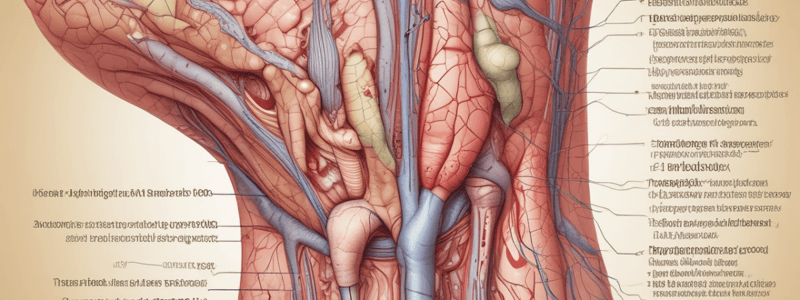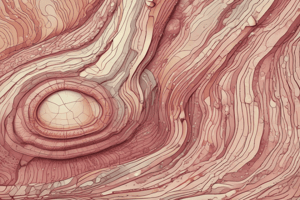Podcast
Questions and Answers
What is the main function of the nails?
What is the main function of the nails?
- To regulate body temperature
- To enhance the sense of touch
- To protect the ends of fingers and toes from over sensitization (correct)
- To produce keratin
What is the functional unit of the muscle?
What is the functional unit of the muscle?
- Sarcomere (correct)
- Sacromere
- Myofibril
- Sarcolemma
What is the most common type of skin cancer?
What is the most common type of skin cancer?
- Squamous Cell Carcinoma
- Adenocarcinoma
- Malignant Melanoma
- Basal Cell Carcinoma (correct)
What is the term for the rapid delivery of action potentials that produce a graded contraction?
What is the term for the rapid delivery of action potentials that produce a graded contraction?
What type of muscle fibers rely mostly on aerobic respiration to generate ATP?
What type of muscle fibers rely mostly on aerobic respiration to generate ATP?
What is the main function of the troponin complex?
What is the main function of the troponin complex?
What is the term for the state of smooth and sustained contraction produced by a volley of action potentials?
What is the term for the state of smooth and sustained contraction produced by a volley of action potentials?
What type of skeletal systems transform muscle contraction into locomotion?
What type of skeletal systems transform muscle contraction into locomotion?
What is the term for the type of movement produced by annelids using their hydrostatic skeleton?
What is the term for the type of movement produced by annelids using their hydrostatic skeleton?
What is the protein that binds oxygen more tightly than hemoglobin does?
What is the protein that binds oxygen more tightly than hemoglobin does?
What is a characteristic of fast-twitch fibers?
What is a characteristic of fast-twitch fibers?
What is the main function of smooth muscle?
What is the main function of smooth muscle?
What is a characteristic of cardiac muscle?
What is a characteristic of cardiac muscle?
What is the main difference between exoskeletons and endoskeletons?
What is the main difference between exoskeletons and endoskeletons?
What is the main challenge of locomotion on land?
What is the main challenge of locomotion on land?
What is the main adaptation of flying animals to reduce body mass?
What is the main adaptation of flying animals to reduce body mass?
What is a characteristic of polysaccharide chitin?
What is a characteristic of polysaccharide chitin?
What is the main function of the autonomic nervous system in relation to smooth muscle?
What is the main function of the autonomic nervous system in relation to smooth muscle?
What is a characteristic of jet propulsion in swimming?
What is a characteristic of jet propulsion in swimming?
What is the main challenge of locomotion in water?
What is the main challenge of locomotion in water?
Which of the following layers of the epidermis is the outermost layer?
Which of the following layers of the epidermis is the outermost layer?
What is the main function of the sebaceous gland?
What is the main function of the sebaceous gland?
Which of the following is a characteristic of the stratum lucidum?
Which of the following is a characteristic of the stratum lucidum?
What is the role of the dermis layer in the skin?
What is the role of the dermis layer in the skin?
What is the function of the arrector pili muscle?
What is the function of the arrector pili muscle?
Which of the following is a type of skin receptor?
Which of the following is a type of skin receptor?
What is the purpose of the melanin produced by melanocytes?
What is the purpose of the melanin produced by melanocytes?
What is the function of the sweat gland?
What is the function of the sweat gland?
What is the characteristic of the hypodermis layer?
What is the characteristic of the hypodermis layer?
What is the purpose of the keratinization process in the skin?
What is the purpose of the keratinization process in the skin?
Flashcards are hidden until you start studying
Study Notes
The Integumentary System
- The integumentary system consists of the skin, accessory organs, and three layers of tissue.
- It provides a physical barrier against most invasions, regulates body temperature, aids in the senses of touch and feel, and protects the body from UV radiation.
The Skin
- The skin is composed of three layers: the epidermis, dermis, and hypodermis.
- The epidermis is made up of stratified squamous epithelium, with no blood vessels to supply nutrients to its cells.
- The dermis is made up of fibrous connective tissue, with collagen and elastic fibers that are continuous with the fibers in the hypodermis.
- The hypodermis is made up of adipose tissue and loose connective tissue, and contains large blood vessels.
Epidermis
- The epidermis has no blood vessels, so nutrients diffuse from the arterioles in the dermis.
- The epidermis has four layers: stratum basale, stratum spinosum, stratum granulosum, and stratum corneum.
- Stratum basale receives most of the nourishment, while stratum corneum is the outermost layer, made up of dead, keratinized cells.
- Keratinization is the process of producing keratin, a protein that makes cells tough and waterproof.
Dermis
- The dermis is made up of fibrous connective tissue.
- It contains arterioles that supply nutrients to the epidermis.
- It also contains collagen and elastic fibers that are continuous with the fibers in the hypodermis.
Hypodermis
- The hypodermis is made up of adipose tissue and loose connective tissue.
- It contains large blood vessels.
- It acts as a heat insulator against the cold climate and stores fat.
Accessory Organs
- The hair, pili arrector muscle, sebaceous gland, sudoriferous gland, and nails are all accessory organs.
- The hair is made up of keratinized cells, and its growth is affected by nutrition and hormones.
- The sebaceous gland produces sebum, which helps to waterproof the skin and hair.
- The sudoriferous gland produces sweat, which promotes evaporation and helps to regulate body temperature.
Functions of the Integumentary System
- Protection: physical, chemical, and biological barriers against external factors.
- Temperature regulation: through sweating, vasoconstriction, and vasodilation.
- Excretion: waste materials such as ammonia, urea, and excess salt are eliminated through sweating.
- Vitamin D synthesis: the epidermal layer of human skin synthesizes vitamin D when exposed to UV radiation.
- Cutaneous sensation: receptors in the skin detect sensations such as heat, cold, pressure, and touch.
Thick Skin vs Thin Skin
- Thick skin has all five layers, and is found in areas where there is a lot of abrasion, such as the fingertips, palms, and soles of the feet.
- Thin skin only has four layers, and is thinner due to the absence of the stratum lucidum layer.### Nails
- Made of keratin
- Protect the ends of fingers and toes
- Prevent over-sensitization of nerve receptors
Burns
- 1st degree burns: only the epidermis is damaged, with redness and swelling
- 2nd degree burns: epidermis and upper region of dermis are involved, with redness, swelling, and blisters
- 3rd degree burns: all layers of skin are burned, requiring a skin graft to repair
Skin Cancer
- Most skin tumors are benign
- Cause of cancer is unknown, but probably due to overexposure to ultraviolet radiation
- Types of skin cancer:
- Basal cell carcinoma: most common, usually benign, and affects cells in stratum basale
- Squamous cell carcinoma: arises from keratinocytes in stratum spinosum, more aggressive than basal cell carcinoma
- Malignant melanoma: most dangerous, cancer of melanocytes in stratum basale, and grows and migrates rapidly
Muscular System
- Types of muscle fibers:
- Oxidative fibers: rely on aerobic respiration, have many mitochondria, rich blood supply, and large amount of myoglobin
- Glycolytic fibers: use glycolysis as primary source of ATP, have less myoglobin, and tire more easily
- Skeletal muscles:
- Striated muscles: have light and dark bands
- Uses ATP from glycolysis or aerobic respiration
- Muscle contraction:
- Requires myosin-binding sites to be uncovered
- Calcium ions bind to troponin complex to expose myosin-binding sites
- Muscle types:
- Slow-twitch fibers: contract slowly, sustain longer contractions, and are oxidative fibers
- Fast-twitch fibers: contract rapidly, sustain shorter contractions, and can be glycolytic or oxidative
Nervous Control of Muscle
- Motor unit: consists of a single motor neuron and all the muscle fibers it controls
- Action potential: produced by a motor unit, results in all muscle fibers within the motor unit to contract
- Graded contractions:
- Can be achieved by varying the number of fibers that contract
- Can be achieved by varying the rate at which fibers are stimulated
- Recruitment: the recruitment of multiple motor neurons results in stronger contractions
Skeletal System
- Types of skeletal systems:
- Hydrostatic skeletons: consist of fluid held under pressure in a closed body compartment
- Exoskeletons: hard external skeletons
- Endoskeletons: internal skeletons
- Functions of skeletal system:
- Provides support and protection
- Allows for movement
- Produces movement through muscle contractions
Locomotion
- Types of locomotion:
- Locomotion on land: walking, running, hopping, or crawling
- Swimming: moving through water
- Flying: moving through air
- Adaptations for locomotion:
- Land: support and move against gravity
- Water: overcome friction
- Air: develop lift to overcome gravity
Studying That Suits You
Use AI to generate personalized quizzes and flashcards to suit your learning preferences.




